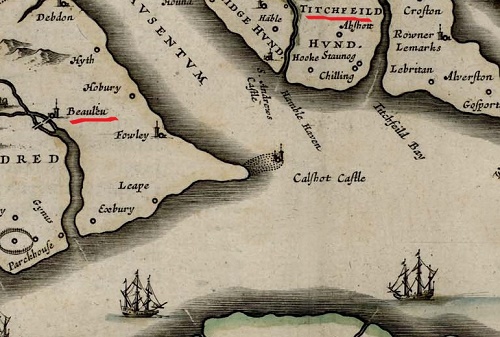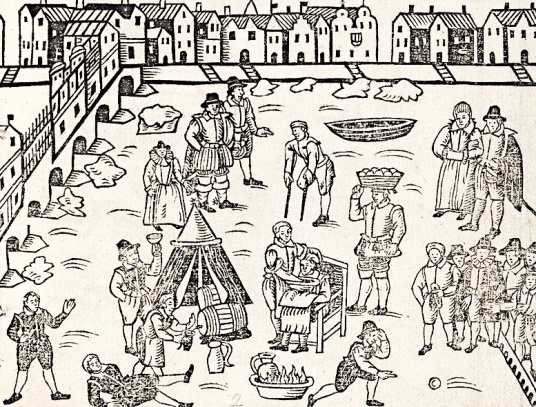
After our All Hallow E’en revel, I returned to Southampton House to await my lord. He was in the country.
King James went to visit him at Bewley [Beaulieu].
My lord was not so fool as to offer him the house, as Sir Rabbit [Robert Cecil] had done.
Instead, King James offered my lord a forest!
Oh, the new year started well for us.

The year did not start well for others. There came newes of terrible rains and great floods in the west country. Houses under water. Many drowned.
I heard this from Onix. We met sometimes to exchange newes in the garden where we first became akwaynt.
He told me cats had no choice but to sit on hills with dogs, foxes, hares, rabbits, and other vermins to ’scape drowning.
We hoped the river here would not rise. Onix sayt all sat peaceable, but we did not wish to find ourselves betwixt hounds and high water.
Next came rejoicings. My lady birthed another he-kit. Not here in the town, but in a house where my lord and lady dwell when my lord is required to follow the King.
King James can never bide in one place for long. Why is he forever riding from one house to another, even in horrid weathers?
True, he loves to hunt, but what is chasing him?
One thing I will say. If our King were a cat, he would fear his own tail.
King James gave Sir Rabbit one of his own houses in return for Tibbles. That house was old, and Sir Rabbit wished to build a new one. My lord was one who helped him choose a fit place for it.
How will Sir Rabbit pay for this house? He built his London house with money he hooked from the old Queen’s purse. Or so my mother sayt.
He’ll have much ado to claw money from King James, who takes all for hisself and his favorites.
Then came sorrow to our household. My lord’s mother, the old Countess in whose house I was born, died. And so did my lord’s sister, she that he called Moll.
I did not know Lady Moll, but I believe her husband Thoms caused her many heart-burnings. He was unkind to their son, and my lord had to seek Sir Rabbit’s aid in smoothing him.

The Pretty Penny died, too. She was sister to the late Earl of Essex. My lord and lady loved her well, and will have a care for her kits, I believe.
All that newes made me think on mine own mother. Was she still in this world? Did she wait for newes of my vengeance on Snakes-Purr?
Onix had heard no word of him.
Winter brought great cold. The river frosted entire in parts.
I heard tales of folk walking from Westminster to the south bank.
I would have liked to see this spectacle, but durst not go so far for fear of frosting myself.

Thus lived I quiet and private until spring, and I could meet Onix again.
He sayt that Picker and Stealer had something they wished me to see.
“What?” I arrkst.
“Proofs of another assalt on Villain Snakes-Purr, I believe,” sayt he.
Did that mean good newes for me?
 Harry had spent the summer and autumn of 1605 at Titchfield and on the Isle of Wight with the Earl of Southampton, but for the next few years he seems to have remained in London.
Harry had spent the summer and autumn of 1605 at Titchfield and on the Isle of Wight with the Earl of Southampton, but for the next few years he seems to have remained in London.
His Earl entertained King James at Beaulieu in September 1606, and James enjoyed himself so much he appointed Southampton as Keeper of the nearby New Forest (once a royal hunting reserve, nowadays a national park). James was back at Beaulieu in 1607, but never seems to have visited Place House at Titchfield. Perhaps Southampton feared he’d take a fancy to it?
Robert Cecil was sorry to part with Theobalds, but it was probably a case of yielding to the inevitable. King James gave him Hatfield manor, with the old palace where Elizabeth I had lived before she inherited the throne. Robert Cecil built the present Hatfield House there.
The Southamptons’ fourth child was born in March 1607 at Little Shelford (south of Cambridge). They’d leased a house there, probably because the village was reasonably handy (but not too close?) to Royston, where James liked to stay when he was not required in London.
Here’s a link to a lecture by architectural historian Professor Simon Thurley; it’s almost 45 minutes long, but at around the 27.50 minute mark he begins an entertaining description of the impact – social and architectural – James had on Royston.
Southampton’s sister Mary (whom Gib called Lady Moll) didn’t have an easy marriage. Her husband, Thomas Arundell, lurched from one crisis to the next. His father turned against him and hated Moll. Later Thomas played the heavy father when his eldest son married the Earl of Worcester’s daughter, Blanche Somerset, without his consent. The Earl of Worcester was a senior member of the Privy Council and a friend of Robert Cecil, so Blanche was a good catch. And if Wikipedia is correct, she proved herself during the Civil War.
Penelope Rich (née Devereux), later the de facto Countess of Devonshire, died of a “fever” in July 1607. She’d spent much of the previous year engaged in legal battles on her own and her children’s behalf with relatives of her late partner Charles Blount, Earl of Devonshire. They contested his will. Despite the fact that Charles’ and Penelope’s marriage was not regarded as legal, the will held good. However, Penelope herself endured vicious personal attacks in the process. A sad final chapter in the life of a remarkable woman.
I quite like the idea of bowling on the Thames. When something similar happened a couple of hundred years later, most of the tents sold alcohol, although there was also a printing press that printed souvenir leaflets. There were also dancing, games and spit-roasted meat. Harry would probably have enjoyed it.
LikeLiked by 1 person
I like the idea of being able to walk across the river! Not much fun for the watermen, though, with no work available.
LikeLiked by 1 person
In the nineteenth century the watermen charged people for access to the ice. I suspect they were no less enterprising in the sixteenth century.
LikeLiked by 1 person
They were complaining in 1608; I read somewhere that King James donated £200 for their relief.
LikeLiked by 1 person
They’d obviously learned what to do by the nineteenth century.
LikeLiked by 1 person
Dire times and much tail frosting – but not to our hero.
LikeLiked by 1 person
He certainly does! I think his early prison experience taught him to stay out of trouble.
LikeLiked by 1 person
What I would give to visit England at this time in history. I had a marvelous story book from the 30’s that had been in our family. There were some excellent child friendly history tales that sparked my interest. Great post. I wonder what fever Penelope died of?
LikeLiked by 1 person
Penelope was about 44 when she died, and to reach that age she must have had a pretty high level of natural immunity. She’d undergone 11 pregnancies and had 9 surviving children – four by her first husband, five by her second. Plus, when she was younger, she’d also survived a bout of smallpox that left her beauty unblemished (as someone at the time observed). So my guess is that her immune system was probably weakened by prolonged stress. First, the “disgrace” of her second marriage in 1605, then her husband’s death in 1606. He’d been her partner since she was about 28. That was followed by the vicious attacks of his relatives who’d contested his will – attacks of the “she ruined his life, drove him to an early grave” variety. Maybe she picked up a virus, or developed a bronchial infection that normally she could have fought off?
LikeLiked by 1 person
Penelope was quite a woman! At least she lived her life fully?
LikeLiked by 1 person
She certainly did.
LikeLiked by 1 person